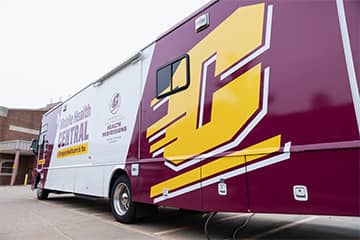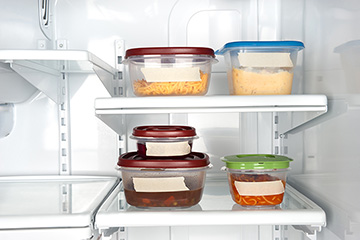Going solo on summer physical fitness
Advice for exercising alone amid COVID-19
Experts on Point is a University Communications series focusing on CMU faculty who have special insights into interesting, important and timely topics.
This summer, a number of organized sports and exercise programs with trained leaders were canceled because of COVID-19, so people of all ages are creating their own regimens. Add to the mix hot and dry weather, and you have a recipe for injury and possibly worse.
![Mug-[Miller]-](/images/default-source/presidents-division/university-communications/news/2021/2021-2/mug--miller--395ff8be-44be-459d-9638-e85ac71a2664.jpg?Status=Master&sfvrsn=b0c019ff_5)
Dr. Kevin Miller, an Athletic Training Program faculty member in the School of Rehabilitation and Medical Sciences, is an expert on heat-related sports injuries. We talked with him about the issue and asked him to share some advice.
Q: What activities should be avoided or reduced under these conditions?
A: It is always important to stay up to date on guidance from local and federal authorities pertaining to health and safety during the COVID-19 pandemic. Activities that place people at a higher risk of communicating or contracting the virus must be avoided, and social distancing guidelines should be followed at all times.
If you have been inactive for a while, consider following these recommendations:
- Consult a health care professional, like an athletic trainer, about your plans to begin or resume activity. They can help you develop safe guidelines that will restore you to your pre-COVID levels of activity. For CMU students, student athletic trainers who are supervised by a licensed athletic trainer at all times are available to anyone with a Student Activity Center membership. SAC members also have access to the free Injury Care Center clinic, staffed by students in our AT program.
- Set goals, but be patient. Changes to the body take time, and rushing back to pre-COVID levels of activity can result in a higher risk of injury, especially in the first seven days of a new workout plan.
- Stay positive. The effects of a pause in training are temporary and reversible in time.
- Develop a structured, weekly plan for return to peak performance. Low-intensity and shorter-duration activities (one to two times a week) should occur first. Then, people can gradually incorporate higher-intensity, sport-specific activities over the first 15 days.
- Remember to incorporate rest days into your physical activity plan, and eat nutritious foods to aid in recovery.
Q: What sports and exercise-related issues and injuries — strains, injuries, heat exhaustion, etc. — can occur in such conditions?
A: Unfortunately, COVID-19 has caused many physically active people to lose access to normal training facilities and has modified normal workout routines. Any time athletes cease competing or exercising at their usual sport-specific intensities and durations for prolonged periods of time, detraining can result.
Detraining reduces the amount of oxygen the body uses during exercise, leads to faster times to exhaustion, and reduces power, muscle size, flexibility and strength. These side effects can occur in as little as two weeks and take several more weeks to fully reverse once training is resumed. Similarly, failing to exercise in the heat can lead to losses in heat acclimatization.
All of these negative effects can lead to a higher risk of musculoskeletal injuries (such as strains or sprains) or heat illnesses (e.g., heat exhaustion or heatstroke).
Q: How should people be treated if they experience any of these?
A: Assuming an injury does not require immediate or advanced medical care, minor sprains and strains can be treated by following the PRICE principle: Protecting the injured body part, resting, icing, compression and elevation. These are useful strategies for limiting further injury to the body and will allow the natural healing process to work more efficiently.
Heat illnesses may require more advanced treatments, depending on how high a person's body temperature became during exercise. For example, heat exhaustion (body temperature less than 104 degrees) can be treated by stopping exercise, putting the person in a cool area such as an air-conditioned room, loosening any restrictive clothing, giving cold fluids to drink and applying cold towels or fanning to the body.
Heatstroke is characterized by a body temperature higher than 105 degrees, along with signs of nervous system distress such as coma, nausea, irritability and confusion. Heatstroke is a medical emergency and must be treated by first placing the patient in a large volume of cold water to reduce body temperature to normal levels in less than 30 minutes and then referring the patient to the hospital for follow-up testing: Cool first, transport second.
Q: What other precautions should people take?
A: Take frequent breaks, and stay hydrated. To decrease the risk of transmitting or contracting COVID-19 during rehydration, don't share water bottles or other water sources such as hoses or mass drinking stations.
Plan your exercise based on the day's conditions. On days with high heat and humidity, it is better to exercise in the morning, when it is cooler, and at a lower intensity or duration than normal.
Overall, maximize safety by being flexible and patient with your fitness goals during this time.
About the expert
Miller joined CMU in 2013. His research interests include the causes, treatments and prevention of exertional heat illness, with a specific emphasis on exercise-associated muscle cramping. He earned a Bachelor of Science degree in human biology from the University of Wisconsin-Green Bay, a Master of Science degree in human performance from the University of Wisconsin-La Crosse, and a doctorate in exercise science from Brigham Young University.



